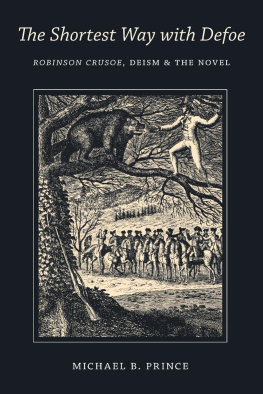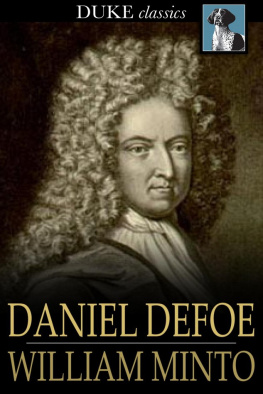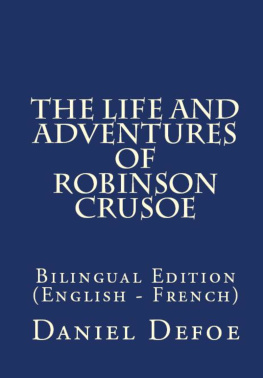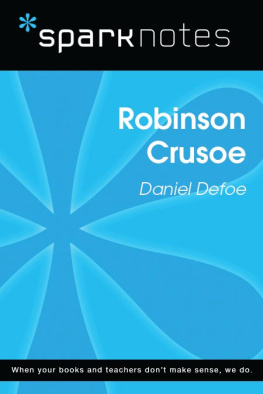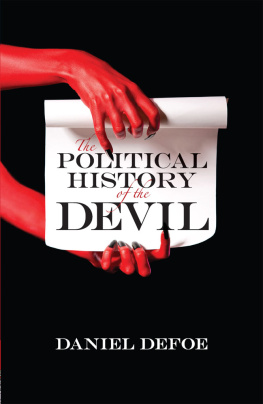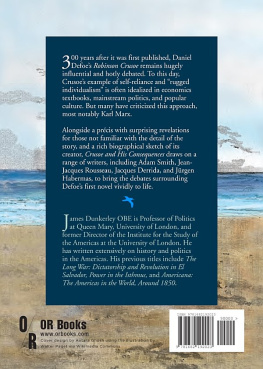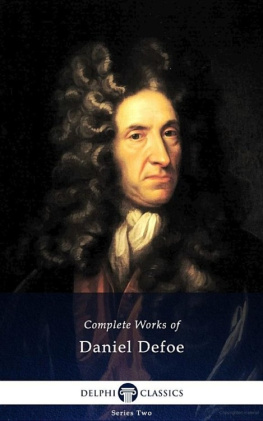Katherine Frank - Crusoe, Daniel Defoe, Robert Knox and the Creation of a Myth
Here you can read online Katherine Frank - Crusoe, Daniel Defoe, Robert Knox and the Creation of a Myth full text of the book (entire story) in english for free. Download pdf and epub, get meaning, cover and reviews about this ebook. City: New York, year: 0, publisher: Pegasus Books, genre: Detective and thriller. Description of the work, (preface) as well as reviews are available. Best literature library LitArk.com created for fans of good reading and offers a wide selection of genres:
Romance novel
Science fiction
Adventure
Detective
Science
History
Home and family
Prose
Art
Politics
Computer
Non-fiction
Religion
Business
Children
Humor
Choose a favorite category and find really read worthwhile books. Enjoy immersion in the world of imagination, feel the emotions of the characters or learn something new for yourself, make an fascinating discovery.

- Book:Crusoe, Daniel Defoe, Robert Knox and the Creation of a Myth
- Author:
- Publisher:Pegasus Books
- Genre:
- Year:0
- City:New York
- Rating:5 / 5
- Favourites:Add to favourites
- Your mark:
- 100
- 1
- 2
- 3
- 4
- 5
Crusoe, Daniel Defoe, Robert Knox and the Creation of a Myth: summary, description and annotation
We offer to read an annotation, description, summary or preface (depends on what the author of the book "Crusoe, Daniel Defoe, Robert Knox and the Creation of a Myth" wrote himself). If you haven't found the necessary information about the book — write in the comments, we will try to find it.
Crusoe, Daniel Defoe, Robert Knox and the Creation of a Myth — read online for free the complete book (whole text) full work
Below is the text of the book, divided by pages. System saving the place of the last page read, allows you to conveniently read the book "Crusoe, Daniel Defoe, Robert Knox and the Creation of a Myth" online for free, without having to search again every time where you left off. Put a bookmark, and you can go to the page where you finished reading at any time.
Font size:
Interval:
Bookmark:
Crusoe
Daniel Defoe, Robert Knox
and the Creation of a Myth
KATHERINE FRANK

PEGASUS BOOKS
NEW YORK
Contents
CHAPTER ONE
Two Writing Men
London, 1719
He sees a lone man on a beach.
January 1719. A chill, late-winter afternoon, dark closing in. A man sits at a table, writing, in a solid, red-brick house on Church Street, Stoke Newington, three miles north of the City of London.
Unlike the man on the shore, Daniel Defoe is far from alone. His wife Mary is somewhere about the house. Also three adult, unmarried daughters, Hannah, Henrietta and Sophia. Defoes life, in fact, is crowded with people: one more grown daughter (married and settled), and two grown sons, both cause for heartache. And beyond his family, booksellers and printers waiting for copy, journalist and political enemies, business contacts, informers, merchants and creditors. Deadlines, bills, legal threats.
But for the moment, Defoe is by himself in his book-lined library in his substantial, three-storey Stoke Newington house, with stables and four acres of grounds, an orchard and gardens. A man now in his fifty-ninth or sixtieth year.
But sitting at his table in Stoke Newington, Defoes bare, wigless head is full of a much younger man on a barren shore, vomiting salt water, running about as though crazed, wringing his hands and beating his chest.
The younger man, of course, is Robinson Crusoe. The surname filched from a long-dead school friend named Timothy Crusogrew up to be a Presbyterian minister, famous for his piety and published sermons.
Crusoe, the young man on the shore, stares out at a listing ship, stranded on rocks that rear like stony monsters out of the sea. Behind the shipwreck, the burning globe of the sun slowly sinks down below the horizon.
Some minutes pass. Now the younger man is cradled high up in the fork of a tree near the shore. He is asleep. The sea lions have stopped howling. The tide is so far out that you can scarcely hear the waves crash on the shore.
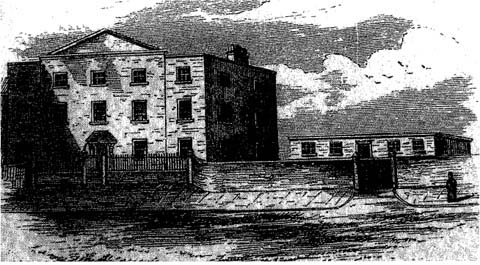
Defoes house in Stoke Newington
Or so it might have happened. This, conceivably, is how it all began.
What we know for certain is that in early 1719 Defoes situation, ensconced in his prosperous-looking Stoke Newington residence with stables and orchard, is not all that it appears to be. He lives in a parish described by a contemporary as pleasantly situated, and full of fine Country Houses for Citizens, being about 3 or 4 miles from London.
From the outside, it looks like a well-to-do gentlemans residence, but within the house is quaint and queer built at several different times, with dark wainscoted walls, narrow passageways and floors made of creaking, uneven boards. There is gossip that Defoe keeps ropes and ladders handy in order to make a swift exit out of a second- or third-storey window should an unwelcome visitor call. Heavy bolts and padlocks secure the doors from the inside. The surrounding gardens and grounds are enclosed by dark, menacingly named alleys: Cutthroat Lane, Hussey Lane and Pawnbrokers Lane.
Two miles south of Defoe in Stoke Newington, an even older man named Robert Knox sits in rented lodgings in the parish of St Peter le Poer writing a letter to his cousin, the Reverend John Strype, who is the vicar of Low Leyton in Essex. Knox and Strype are both nearly eighty, the sole family survivors of their generation, as Knox often reminds his cousin. There has been a close bond between them since childhood. Occasionally they meet up, though not often enough for Knox, who knows that Strype, despite his advanced years, still crosses the River Lea to London most weeks to confer with his antiquarian friends.
Unlike Strype, Knox has no wife or children. Unlike Defoe, he is well off. He could afford to own an establishment as large as Defoes rented house in Stoke Newington. But in 1700, when Knox retired from his career as a sea captain, he chose to settle in a lodging Chamber in the home of the Bartlett family in St Peter le Poer, a parish that was once, as its name indicates, impoverished, but is now filled with many fair Houses, possessed by rich Merchants, and others. Behind the Bartletts house Knox has, with the Concent [sic] of the Landlord, inclosed a corner of the Court with a bricke wall to make me a small garden in the City of London & planted trees therein, which gives him great content.
But it is a lonely life for the old man. Idle and droneish is how Knox describes his days to Cosen Strype. Knox spent much of his life sailing the world in the service of the East India Company. Now he is too infirm even to take the walks to Hackney Marsh that he used to relish. All his friends from his seafaring days and the Royal Society have died. He hasnt seen his adopted daughter for nearly forty years. Even the widows who pursued Knox when he first retired have given up or found solace elsewhere.
In their letters Knox and Strype exchange news of poor and ailing relations and describe the symptoms of their own illnesses. Knox reports on his violent frequent fitts of Gravell and recurrent head ake, a disease, he remarks to Strype, incident to our family. Knox has recently received news that Strype has suffered a stroke in the pulpit while preaching his Sunday sermon. Knox explains that he has been unable to visit Strype because of an itching disposition, but he promises to call on his afflicted cousin as soon as he is able to make the coach journey to Low Leyton. When Strype receives Knoxs letter he neatly endorses it on the back: Capt Knox Notice of my sudden illness while I was at divine service. His present distemper An itching. Both our great Ages.
In their frequent letters to each other, Knox and Strype also discuss the books they are writing. Strype is labouring to complete his long-delayed, updated edition of John Stows Survey of London, first published in 1598. Knox has toiled even longer on what he calls my Booke of Ceylon with Maniscripts [sic] of my owne Life. For the past twenty years, since Knox retired, his Booke has occupied most of his waking hours.
Knoxs An Historical Relation of the Island Ceylon was originally published nearly forty years earlier, in 1681, by Richard Chiswell, Printer to the Royal Society, at the Rose and Crown in St Pauls Churchyard. The title page distils its extraordinary contents: An Historical Relation of the Island Ceylon in the East Indies: Together with an Account of the Detaining in Captivity [of] the Author and divers other Englishmen now Living there and of the Authors Miraculous Escape. By Robert Knox, a Captive there near Twenty Years.
The story this book relates is amazing and unprecedented. In 1660, at the age of nineteen, Knox was stranded on Ceylon and taken captive by the King of Kandy. His fathers ship, an East Indiaman called the Anne, had been badly damaged in a mighty storm off the Coromandel Coast of India. Leaking badly, the ship was forced to seek refuge on Ceylon, the tear-shaped island off the south-eastern tip of India.
Captain Robert Knox (after whom his son was named) sailed into the harbour of Trincomalee on the eastern side of the island in order to repair his disabled ship. Much of Ceylon at this time was under the control of the Dutch East India Company the great rival of the British East India Company in whose service the Anne sailed. But the native King of Kandy still ruled over a large territory at the heart of the island, and the Dutch had abandoned their fort at Trincomalee which now had a native governor. Captain Knox hoped that Trincomalee would provide a safe haven in which to repair the ship, and that he and his men would remain unnoticed or at least undisturbed by both the Dutch authorities and the natives.
Next pageFont size:
Interval:
Bookmark:
Similar books «Crusoe, Daniel Defoe, Robert Knox and the Creation of a Myth»
Look at similar books to Crusoe, Daniel Defoe, Robert Knox and the Creation of a Myth. We have selected literature similar in name and meaning in the hope of providing readers with more options to find new, interesting, not yet read works.
Discussion, reviews of the book Crusoe, Daniel Defoe, Robert Knox and the Creation of a Myth and just readers' own opinions. Leave your comments, write what you think about the work, its meaning or the main characters. Specify what exactly you liked and what you didn't like, and why you think so.


